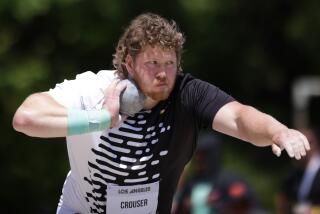Making Her Point : Single-Mindedness Helps Take Sharpshooter to the Top of the Dart World
- Share via
Stacy Bromberg has always preferred doing things her way.
She put herself through college and law school, even though her parents offered to pay. When she decided as a 20-year-old tennis fan that it was time to see Wimbledon, she took a semester off from college, ordered her tournament tickets and toured Europe--alone.
Such single-mindedness may explain why Bromberg, a 37-year-old legal researcher from Hermosa Beach, has become the country’s highest-ranked female dart player only six years after taking up the sport.
For two years she has been the top female player in the United States. And this year she was runner-up in the world championship of dart throwing, held in Las Vegas.
Through it all, Bromberg’s strong suit has been concentration.
“When I’m up there, nothing else exists,” Bromberg said. “You don’t realize how much energy you’re using just trying to stay focused. When I first started getting serious about darts, I would come home with tremendous headaches.”
*
Bromberg, who was brought up in Culver City, started entering dart competitions in 1987. Her future husband, Ron Dove, himself a former dart professional, saw her throwing in the Scarlet Lady pub in Culver City and told her that she had potential. A few days later, Bromberg asked him to coach her.
Dove (pronounced doe-VAY) had a hand in Bromberg’s first singles tournament win just four months later. She and a partner had entered and won the ladies’ doubles tournament. As Bromberg was preparing to go home, Dove encouraged her to enter the ladies’ singles event.
“I told him, why throw away the $15 it cost to enter the (singles) tournament?” Bromberg said. “He offered to pay my entry fee and told me that if I won, I could give him 50 percent of my winnings.
“After I won the $200, I thought he’d be a nice guy and only ask for the $15 back,” she said. “So I offered him $100, and he took it and put it in his pocket and said, ‘Thank you.’ ”
The couple married this year. Joked Bromberg: “I married him to get my hundred bucks back.”
Bromberg now spends 45 weekends each year traveling the world and playing in tournaments. Though Dove confesses that his weekends are lonely, he is proud of his wife’s achievements.
“Most people don’t have the discipline to become the best that they can be. They just become good enough,” he said. “Stacy is going to do the best that she can regardless of what she goes after. She’ll take it to the highest level possible.”
The American Dart Assn. sanctions more than 200 dart tournaments each year. Though close to $1.5 million in prize money is awarded in tournaments for both sexes, the payoff in most matches is minimal.
In a good year, Bromberg said, she could probably win $20,000. She plays for the money as much as for the competition, saying her winnings are a welcome supplement to the income from her legal research business.
She started that business in 1985 after working as a clerk in a personal injury law firm--an experience that made the law school graduate realize she did not want to become a lawyer.
“Everyone’s entitled to a million dollars, and they want you to get it for them,” Bromberg said between practice throws in her kitchen. “I didn’t want to hear it. I’m just not cut out to be a lawyer.”
*
So she concentrated on doing what she liked best--the research legwork for legal cases.
And darts.
In her first World Cup championship appearance--in the Netherlands in 1991--she lost in the early rounds to a local woman because, she said, her concentration was off.
“I went over there, and in my mind I had the ability,” Bromberg said. “She had three hundred people cheering for her. I thought to myself, ‘I want the hometown advantage.’ ” Two years later, Bromberg got her wish, give or take a few hundred miles.
Last month, the World Cup championships--which are held every other year--took place at the Sahara Hotel in Las Vegas. There, Bromberg defeated women from Malaysia, the Bahamas, Italy, Canada, the Netherlands and Norway to advance to the finals.
Her opponent was another American--Kathy Maloney, who captured the U.S. title in 1985 and 1986 and a World Cup team championship in 1987. It was the first-ever all-U.S. final.
Dart matches are settled in a best-of-seven series. Bromberg and Maloney played seven games. When the 18-minute match was over, Maloney--known on the circuit as No Baloney Maloney--was crowned the best women’s dart player in the world.
“I think I played an incredibly good final,” Bromberg said of her performance. “It was just her day.”
But she added: “I wish I could play it over again one million times.”
Still, Bromberg remains the women’s U.S. National Point Champion, ahead of Maloney by eight points. With only two U.S. tournaments left, the winner will most likely be decided in the last match of the year, in Atlantic City in December.
Bromberg, not surprisingly, likes her chances.
“You have got to believe that you can do anything,” she said. “It may not happen, and if you don’t succeed, you’re amazed, you’re flabbergasted. But I know that on any given day, I can beat anybody in the world.”
A Test of Physical and Mental Skill * Dart throwing began during the Crusades, according to Della Fleetwood of the American Dart Organization. To maintain their bow-and-arrow prowess during winter months when there was no fighting, crusaders shortened their arrows to dart size and flung them into hanging wine casks.
* Today, professional dart matches are played in hotel banquet rooms. Players share the stage with an announcer and two scorekeepers, one on each side of the dart board.
* The players, in addition to being master hurlers, must also be lightning-quick mathematicians. Each player begins the game with 501 points. The first player to reduce that score to zero wins.
* The 18-inch round board is divided into 20 pie-shaped sections, each valued at between one and 20 points. Players can double these points by throwing the dart into a band three-eights of an inch wide on the section’s outer edge.
* Hitting a three-eighths-of-an-inch band on each section’s inner edge counts triple. Thus, if a dart lands in the innermost rim of the 20-point section, the player gets 60 points.
* The “bull’s-eye” in the center of the board, worth 50 points, is not the prime target. Since each player throws three darts per round, the highest score possible is attained by throwing three 60s for 180 points.
* After each throw, players total their score, subtract from their previous score and figure out what they need to score next to reach zero with the fewest number of throws. To complicate matters, a player must get a double on the final toss.
* Bromberg, who often throws in charity matches, wants to teach darts to schoolchildren because of the mathematical acumen the game requires.
More to Read
Go beyond the scoreboard
Get the latest on L.A.'s teams in the daily Sports Report newsletter.
You may occasionally receive promotional content from the Los Angeles Times.










